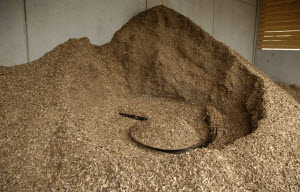Understanding Air Pollution from Biomass Burners Used for Heating
As many places in the U.S. and Europe increasingly turn to biomass rather than fossil fuels for power and heat, scientists are focusing on what this trend might mean for air quality — and people's health.
 Scientists are finding ways to reduce emissions from woodchip burners.Ulrichulrich, Wikimedia CommonsOne such study on wood-chip burners' particulate emissions, which can cause heart and lung problems, appears in the American Chemical Society journal Energy & Fuels. The scientists say the findings could help manufacturers reduce the negative impact of this fuel in the future.
Scientists are finding ways to reduce emissions from woodchip burners.Ulrichulrich, Wikimedia CommonsOne such study on wood-chip burners' particulate emissions, which can cause heart and lung problems, appears in the American Chemical Society journal Energy & Fuels. The scientists say the findings could help manufacturers reduce the negative impact of this fuel in the future.
Aki Kortelainen and colleagues note that in Europe, burning wood for heat is one of the biggest sources of fine particulate emissions, contributing about the same amount of these tiny bits of pollution to the air as vehicles on a busy street. All totaled, these emissions — which have been linked to irregular heartbeats, breathing problems and nonfatal heart attacks — are associated with 350,000 premature deaths every year across Europe. In the U.S., the Centers for Disease Control and Prevention estimates that a 10 percent reduction in these particles of dust, soot and smoke could save at least 13,000 lives annually. With the rise in wood chip burners, Kortelainen's team wanted to better understand the technology's potential impacts on pollution and health.
The researchers measured fine particulate emissions from a wood-chip burner and found that emissions varied as the fuel went through different stages of combustion. They conclude that emissions can be reduced if burning efficiency can be maintained at a high level. The finding, they say, could help the industry design units that are less polluting and less harmful to people.
The authors acknowledge funding from the Academy of Finland Centre of Excellence program and ERA-NET Bioenergy BioHealth project.
